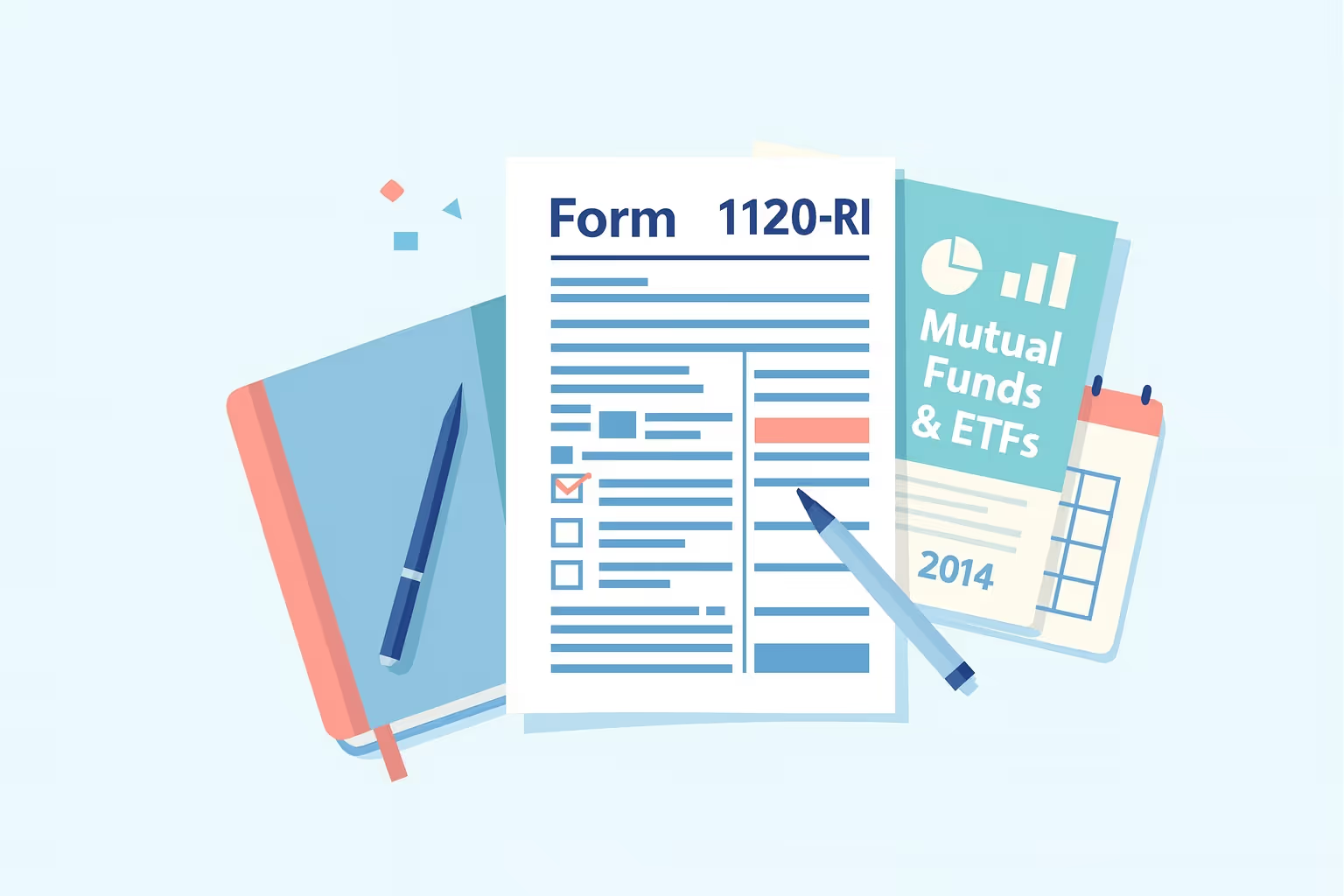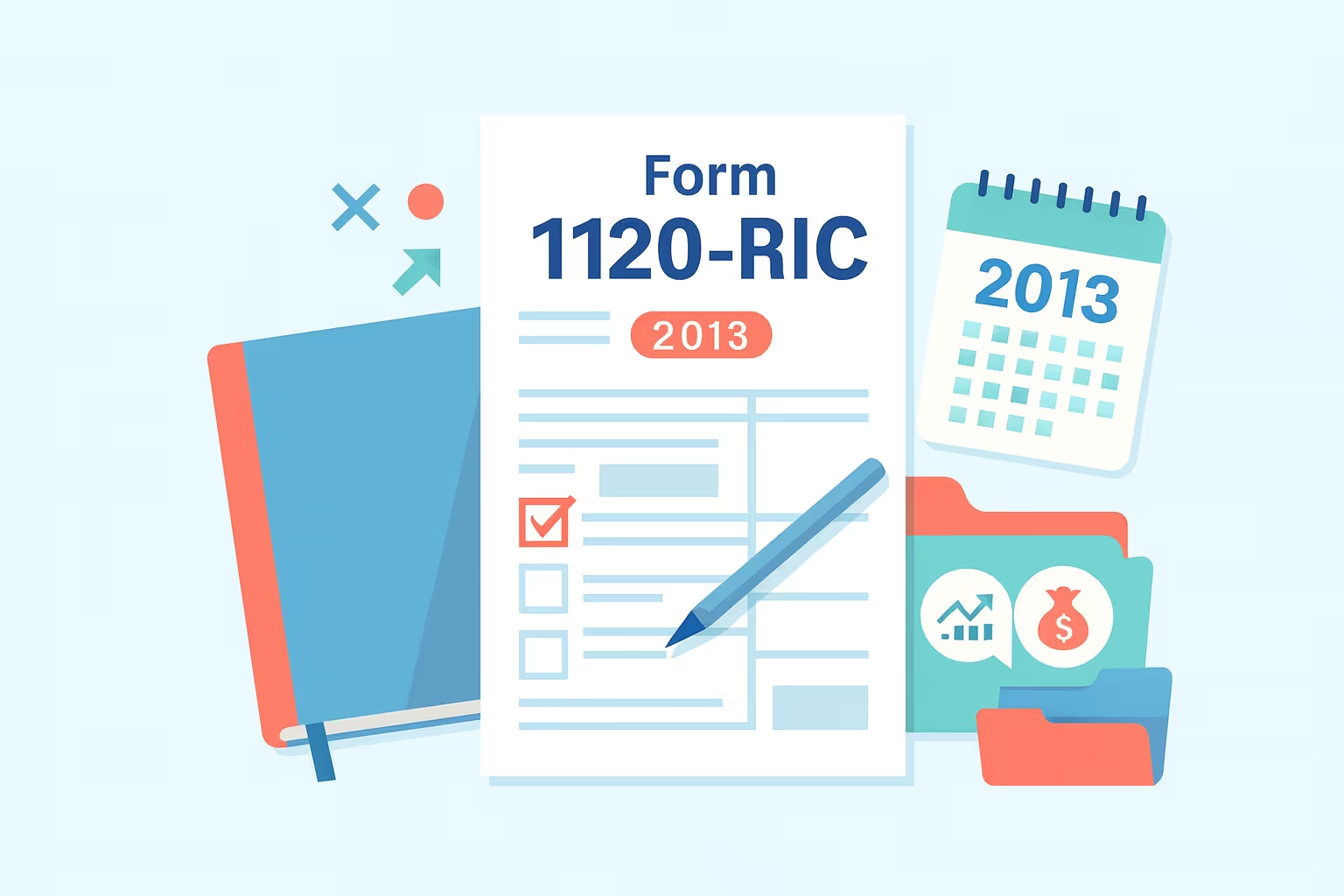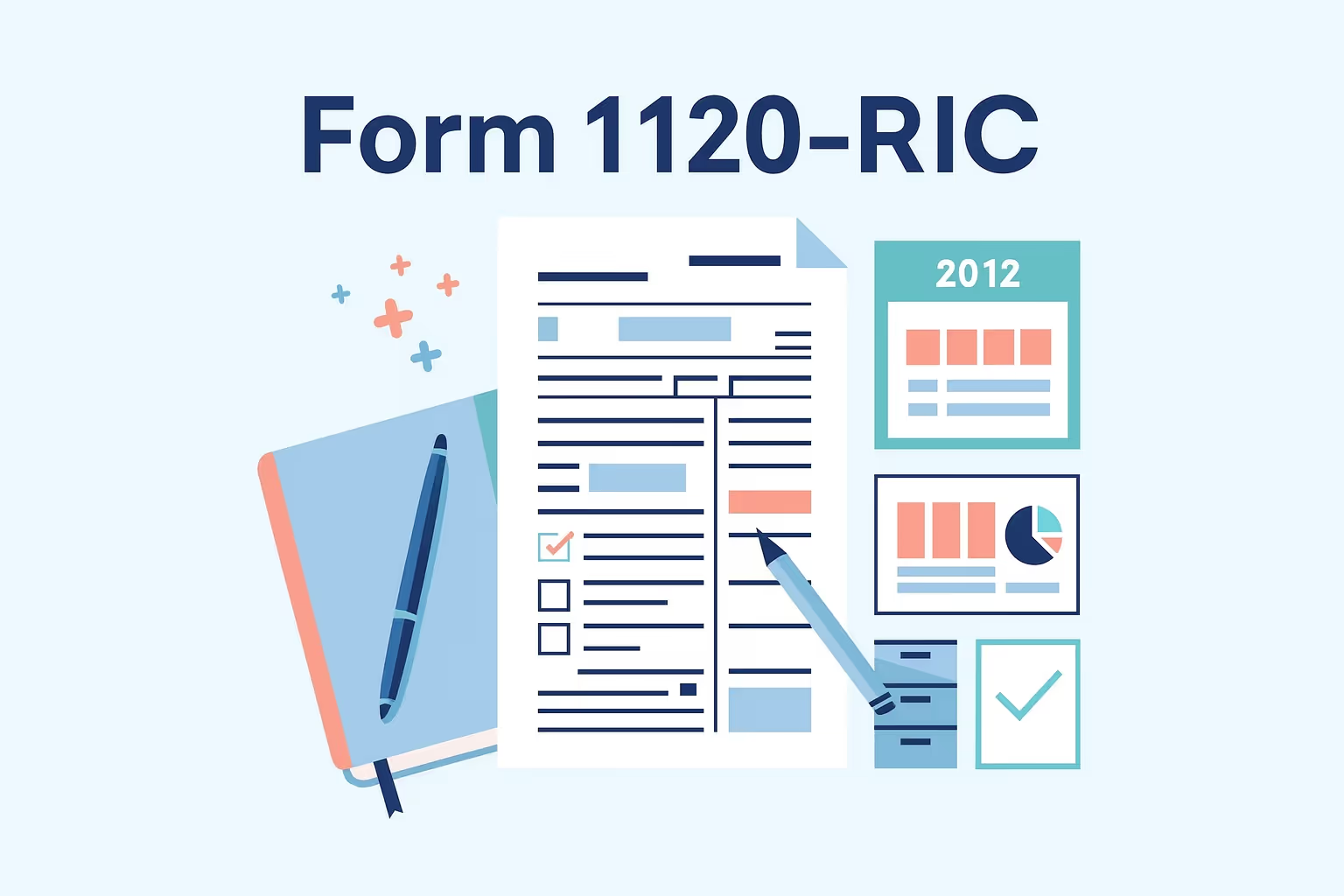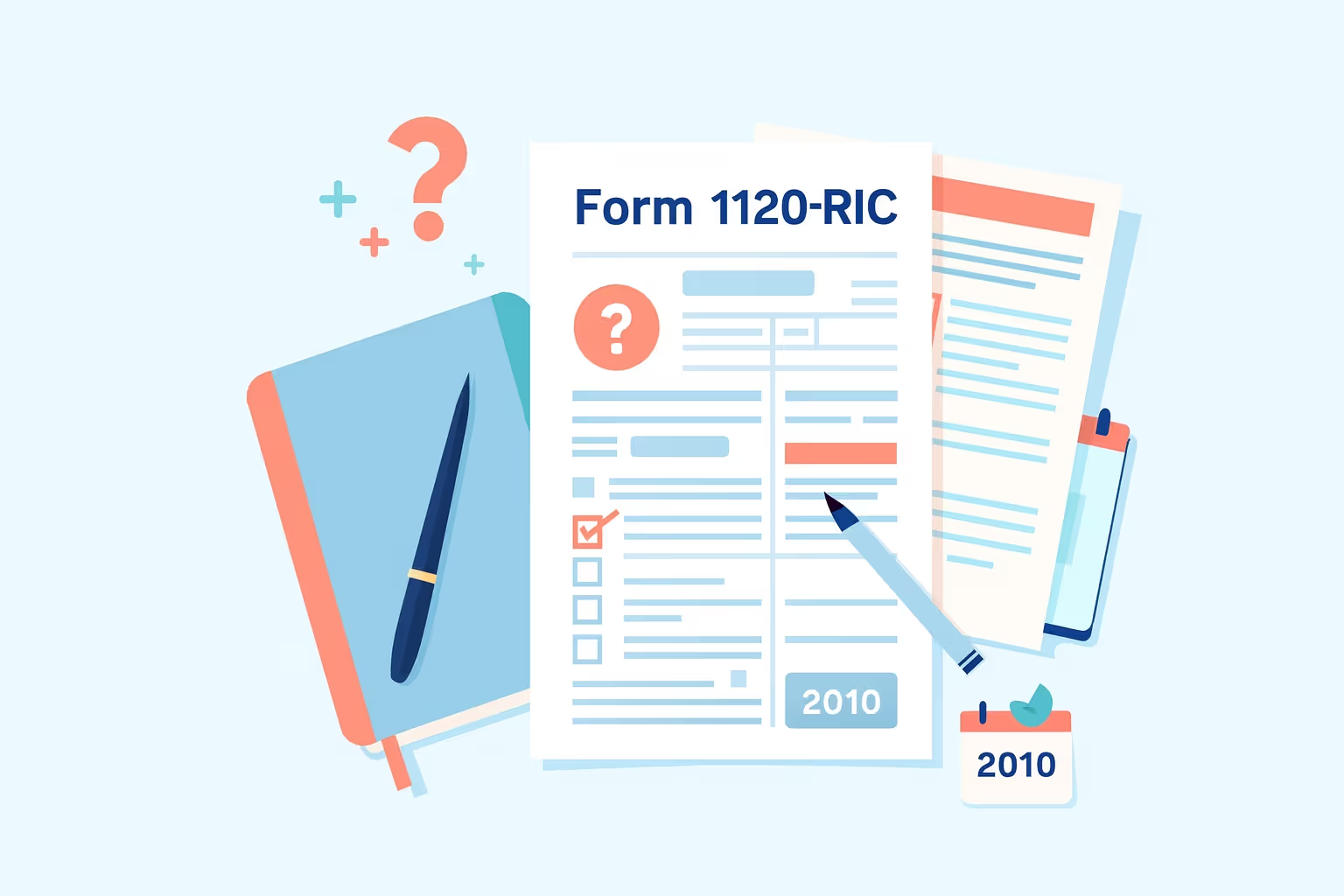Form 1120-RIC 2011 Instructions for Mutual Funds and ETFs
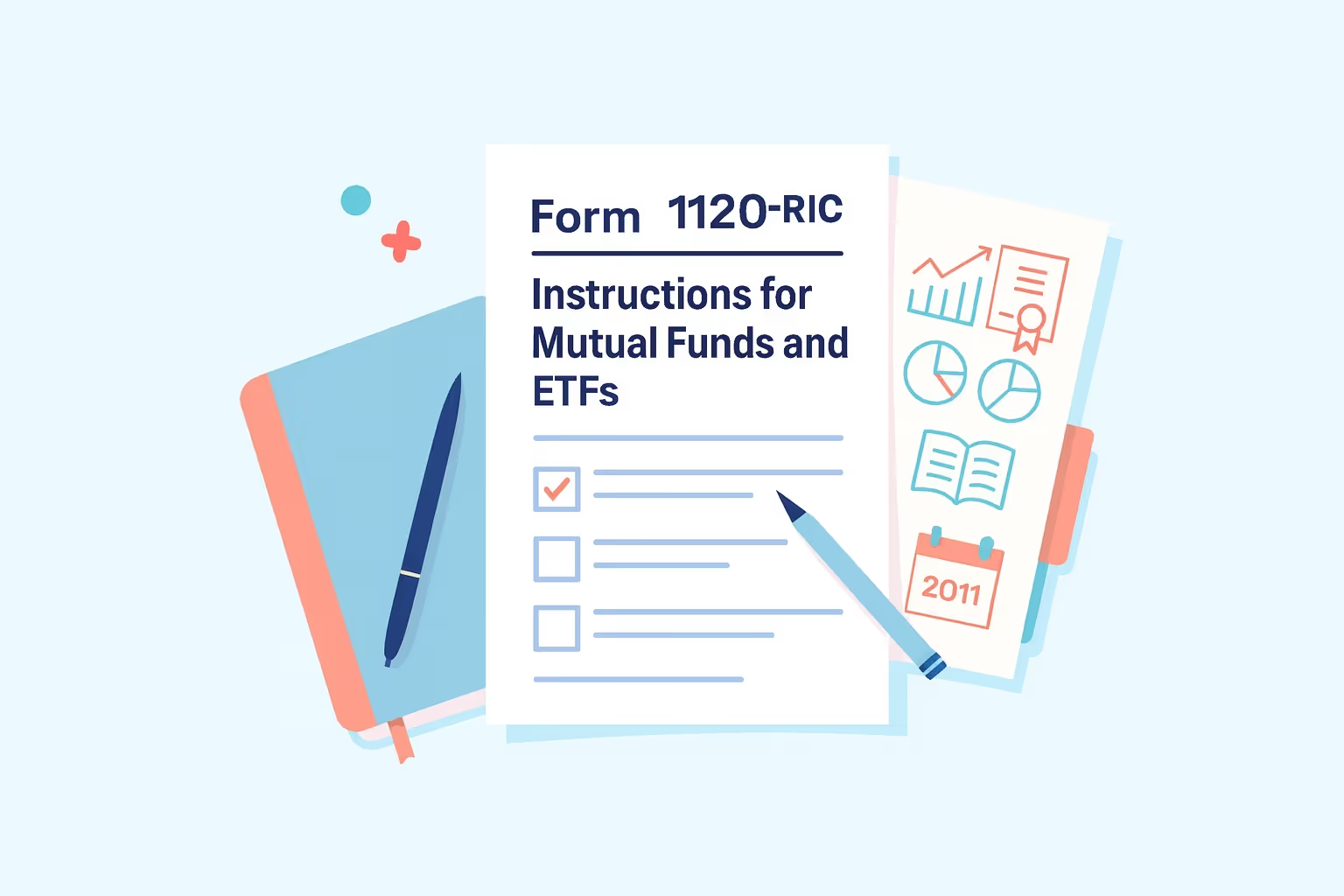
Filing Form 1120-RIC for tax year 2011 is an essential step for mutual funds and exchange-traded funds (ETFs) qualifying as Regulated Investment Companies (RICs) under Internal Revenue Code Section 851. This form allows RICs to report income, deductions, gains, and dividends paid to shareholders while maintaining their tax-favored status. Proper filing ensures compliance with IRS requirements and prevents double taxation on distributed earnings.
Many investment companies face challenges when preparing this return because Form 1120-RIC includes detailed schedules and specific qualification tests that must be met. Standard sections, such as Schedule A for dividends paid and Schedule J for tax computation, require precise data and supporting documentation. Understanding how each part connects simplifies the process and reduces the risk of omissions or errors. By following a structured approach, RICs can meet reporting deadlines, fulfill distribution obligations, and avoid unnecessary interest charges or compliance actions.
This guide provides clear, step-by-step instructions designed for fund managers, accountants, and compliance officers. It covers eligibility criteria, income reporting, and payment requirements using plain language for better clarity. The IRS Form 1120-RIC Instructions (2011) explain each section of the form, outline filing procedures, and describe updates for the 2011 tax year. Reviewing the official instructions supports accurate and timely submissions.
Understanding Regulated Investment Companies (RICs)
A Regulated Investment Company (RIC) is a domestic corporation that meets specific requirements under Internal Revenue Code Section 851. RICs are typically mutual funds, exchange-traded funds (ETFs), or business development companies formed to pool investor assets and distribute income generated from dividends, interest, and capital gains. When a fund qualifies as a RIC, it is taxed primarily on undistributed income rather than total earnings.
The RIC structure shifts the tax burden to shareholders on distributed amounts, reducing double taxation. To maintain RIC status, an entity must satisfy four qualification tests: organizational, income, asset diversification, and distribution. The organizational test requires the company to be a domestic corporation formed as a management or investment entity.
The income test requires that at least 90% of gross income be derived from dividends, interest, and gains on securities. The asset diversification test requires that at least half of the fund’s total assets consist of cash, government securities, or diversified investments. The distribution test ensures that at least 90% of taxable income and net tax-exempt income is paid out annually to shareholders.
RICs benefit from favorable tax treatment only when all criteria are met. Failing a qualification test subjects the company to standard corporate tax rates, removing pass-through treatment. Management teams should maintain accurate records, conduct quarterly asset reviews, and verify income sources to preserve RIC eligibility.
- Maintain accurate accounting and transaction records for all investment activities.
- Perform quarterly asset reviews to confirm compliance with diversification thresholds.
- Verify income sources and document qualification calculations for IRS review and approval.
Mutual funds and ETFs often elect RIC status because it aligns tax liability with the distributions made to shareholders, thereby minimizing tax burdens. Aligning tax liability with shareholder distributions promotes transparency and ensures investors receive income that reflects fund performance.
Business development companies may also qualify when they operate under the Investment Company Act of 1940 and focus on investment activities rather than active business operations. Earning RIC status helps these entities maintain investor trust and comply with federal reporting standards.
Equitable tax treatment across shareholder groups depends on proper RIC classification. Understanding RIC qualification rules lays the foundation for precise completion of Form 1120-RIC, ensuring long-term compliance that strengthens investor confidence in the fund’s financial integrity.
Overview of the RIC Income Tax Return
Form 1120-RIC serves as the primary filing document for regulated investment companies (RICs) to report taxable income, deductions, credits, and shareholder distributions. Each section fulfills a distinct reporting requirement, enabling mutual funds, exchange-traded funds (ETFs), and business development companies to meet the IRS's reporting standards. Understanding the form’s structure helps filers organize data, minimize errors, and demonstrate eligibility for RIC status.
Header Information
- Filers must enter the legal name, address, and Employer Identification Number (EIN) on the form.
- They should also provide the date of incorporation and the total year-end assets.
- Checkboxes must be selected to indicate whether the return is amended or final.
All details must match official corporate records. Accuracy ensures the IRS validates the filer’s entity information before reviewing financial data.
Part I – Taxable Income
- Filers must report income from dividends, interest, securities lending, and foreign currency transactions.
- They should also include deductions for officer compensation, interest, depreciation, and management fees.
Figures should align with audited statements and internal records. Consistency between reported income and supporting schedules reinforces the reliability of the return.
Core Schedules
- Schedule A – Dividends Paid Deduction: Lists shareholder distributions eligible for deduction.
- Schedule B – Tax-Exempt Interest: Reports municipal or exempt interest income and related expenses.
- Schedule J – Tax Computation: Calculates total tax, adjustments, and excise tax on undistributed income.
Each schedule must reconcile with the main form and include documentation for all reported items.
Supporting Forms and Guidance
RICs often attach additional forms, such as Form 8613 for excise tax, Form 1125-E for officer compensation, and Form 1098 for property sales. Attaching these in the correct order ensures a complete submission package. The IRS provides detailed preparation standards in Publication 542, "Corporations," which explains corporate compliance rules and recordkeeping methods.
Completing Form 1120-RIC precisely promotes reliable tax reporting and preserves RIC eligibility. A well-prepared return demonstrates transparency, supports compliance, and builds confidence with investors and regulators.
Reporting Investment Income and Deductions
Accurate reporting of investment income and deductions on Form 1120-RIC enables regulated investment companies (RICs) to determine their taxable income and maintain compliance with IRS requirements. Each income and expense category requires careful documentation to ensure that reported amounts align with financial statements and supporting records. Mutual funds, exchange-traded funds (ETFs), and business development companies must organize this data clearly to preserve RIC status and avoid IRS adjustments or amended returns.
Investment Income Categories
RICs must include all income derived from investment activities. Primary sources include:
- Dividends: Payments from domestic and foreign corporations.
- Interest: Income from bonds, notes, loans, or other interest-bearing assets.
- Securities Lending Payments: Fees earned when lending securities to other parties.
- Foreign Currency Gains: Profits realized from foreign exchange transactions related to investments.
Each category corresponds to a specific line on Form 1120-RIC. Consistent classification ensures accurate computation of total income and supports compliance with income test requirements under Internal Revenue Code Section 851.
Common Deduction Types
The deduction section allows RICs to report operating costs that directly support fund management. Common deductions include:
- Officer Compensation: Salaries and related expenses for key executives.
- Interest Expenses: Costs associated with borrowing used to finance investment operations.
- Depreciation: Allowable write-offs for tangible property and equipment used in the business.
- Professional Services: Fees for accounting, legal, or advisory support related to fund compliance.
Substantiate each deduction with detailed records such as invoices, contracts, and payment confirmations. Proper reporting ensures that deductions reflect legitimate business expenses and meet IRS examination standards.
Importance of Documentation
Maintaining complete documentation for income and deduction entries strengthens the credibility of the return. Records should include investment statements, loan agreements, and receipts for advisory or administrative costs. Proper organization supports efficient reviews and minimizes the likelihood of disputes or adjustments during audits.
Practical Reporting Considerations
RICs should verify that income and deductions reconcile with financial statements before filing. Inconsistent figures may prompt an IRS review or adjustments. Reviewing entries for arithmetic accuracy, consistent categorization, and appropriate schedule placement ensures a complete and compliant return.
Accurate income and deduction reporting demonstrates financial integrity and operational discipline. It confirms that the company meets statutory requirements, protects eligibility for RIC tax treatment, and enhances transparency for investors and regulators.
Capital Gains and Exempt-Interest Dividends
Accurate reporting of capital gains and exempt-interest dividends is essential for regulated investment companies (RICs) filing Form 1120-RIC. These components determine taxable income, distribution obligations, and compliance with the Internal Revenue Code. Following a structured process ensures each figure reflects verified investment data and supports RIC compliance.
Step 1: Identify Capital Gain Transactions
Begin by reviewing all investment transactions completed during the tax year. Separate gains into short-term (held for one year or less) and long-term (held for more than one year). This classification determines how profits are taxed and where they must be reported on Form 1120-RIC.
Step 2: Record Gains on Required Schedules
Use Schedule D to summarize capital gains and losses. Include all short-term and long-term transactions. If any sales involve business property, complete Form 4797 and transfer totals to Schedule D before finalizing entries.
Step 3: Transfer Results to the Main Form
Once totals are calculated, report the net gain on Part I – Investment Company Taxable Income. Verify that all related figures reconcile with supporting brokerage statements. Aligning these amounts with underlying records helps avoid discrepancies that could prompt IRS review.
Step 4: Calculate and Report Exempt-Interest Dividends
Determine exempt-interest income derived from municipal bonds or other tax-exempt securities. Report these figures on Schedule B – Tax-Exempt Interest, including:
- Total tax-exempt interest received during the year
- Expenses related to earning this income
- The portion of the exempt interest distributed to shareholders
Ensure the reported amount matches the exempt-interest dividends disclosed on shareholder Form 1099-DIV statements.
Step 5: Review Allocations and Documentation
Confirm that all entries correspond with investment statements and accounting records. Reconcile totals between Schedules A, B, D, and Part I to ensure consistency across the return. Maintain copies of all supporting documents, including contracts, sale confirmations, and income reports.
Accurate preparation of capital gain and exempt-interest dividend schedules demonstrates disciplined reporting and compliance with RIC standards. Structured documentation strengthens audit readiness, ensures shareholder accuracy, and supports ongoing eligibility for pass-through tax treatment.
Filing Requirements and Deadlines
Meeting filing requirements on time ensures that a regulated investment company (RIC) remains compliant with federal tax laws. Form 1120-RIC must be completed with supporting schedules and submitted within strict deadlines. Proper preparation, timely filing, and accurate documentation help prevent interest charges and safeguard eligibility for RIC tax treatment.
Key Filing Requirements
- Entity Eligibility: The filer must qualify as a domestic corporation under Internal Revenue Code Section 851.
- Registration: The company must operate under the Investment Company Act of 1940 as a mutual fund, exchange-traded fund (ETF), or business development company.
- Income and Asset Tests: Ensure compliance with 90% income and diversification standards.
- Distribution Test: Confirm that 90% or more of taxable income and net tax-exempt income has been distributed to shareholders.
- Employer Identification Number (EIN): Verify the EIN matches the IRS business account.
Filing Deadlines
- Standard Due Date: The 15th day of the 3rd month after the end of the tax year.
- For calendar year filers, the deadline is March 15.
- For calendar year filers, the deadline is March 15.
- Fiscal Year Filers: Use the same rule, counting three months from the fiscal year-end.
- Extension Request: File Form 7004 by the original due date to request a six-month extension. The extension grants additional time to file but not to pay any tax due.
Filing Methods
- E-File: Recommended for faster processing, accuracy, and confirmation of receipt.
- Paper Filing: Permitted for entities not subject to mandatory e-filing rules.
Ensure that all forms, schedules, and attachments follow the proper sequence outlined in the IRS instructions.
Pre-Filing Checklist
- Reconcile all income, deductions, and distributions.
- Review arithmetic accuracy across all schedules.
- Attach the required forms, such as Form 8613, Form 1125-E, and Form 4797, if applicable.
- Confirm the signature of an authorized officer.
- Retain copies of the return and supporting documents for at least three years.
Accurate preparation and timely filing reflect a disciplined compliance process. Following these requirements protects the company’s tax status, supports transparent reporting, and promotes confidence among regulators and shareholders.
Payment Instructions and Estimated Taxes
Every regulated investment company (RIC) must pay taxes electronically and comply with all federal income tax requirements to maintain good standing with the Internal Revenue Service. Meeting payment obligations on time reduces interest charges, protects the fund’s RIC status, and ensures income tax liability is accurately settled. The following process outlines each step for completing payments, managing estimated installments, and maintaining compliance.
Step 1: Enroll in the Electronic Federal Tax Payment System
RICs must submit federal income tax deposits using the Electronic Federal Tax Payment System (EFTPS). Enrollment requires:
- Registering on the Electronic Federal Tax Payment System (EFTPS) portal with the fund’s Employer Identification Number (EIN)
- Linking a valid business bank account to authorize transactions
- Receiving a Personal Identification Number (PIN) through the mail for secure access.
Once enrolled, the fund can schedule future payments, view its history, and generate receipts for recordkeeping purposes.
Step 2: Schedule Payments and Confirm Processing
Funds should schedule payments at least one business day before the due date. The EFTPS system allows same-day wires to be processed before the cutoff time. Always confirm completion through the receipt number provided after each transaction and store all confirmations in the fund’s accounting records.
Step 3: Calculate and Pay Estimated Taxes
RICs expecting to owe $500 or more in tax must make quarterly estimated payments. Each installment should reflect taxable income, mutual fund income, and adjustments for employment credits. Due dates for calendar year filers are:
- April 15
- June 15
- September 15
- December 15
Review each quarter’s income, capital gain distributions, and mutual fund distributions before remitting payments to ensure accuracy.
Step 4: Reconcile Payments with Tax Liabilities
Before filing Form 1120-RIC, reconcile all payments made through EFTPS with the income tax liability reported on the return. Ensure entries align with Schedule J – Tax Computation, including adjustments for applicable employment credits. Any outstanding balance must be paid electronically by the filing deadline to avoid interest assessments.
Step 5: Maintain Payment Compliance
Appoint a tax professional or financial advisor to oversee payments and verify federal income tax deposits. Establish internal review procedures for authorization, scheduling, and reporting. Keeping a documented audit trail supports transparency, accuracy, and regulatory compliance.
Timely electronic payments and accurate estimates demonstrate sound financial governance and procedural compliance. A consistent payment process reinforces operational discipline, minimizes compliance risks, and confirms that the fund has satisfied all federal tax obligations.
Maintaining Tax Compliance and First-Time Filer Guidance
Maintaining long-term tax compliance necessitates consistent documentation, accurate reporting, and adherence to the Internal Revenue Service's established regulatory standards. For first-time filers, understanding procedural steps and establishing reliable internal systems ensures that all requirements for a regulated investment company (RIC) are met from the beginning. A proactive approach strengthens recordkeeping, prevents filing errors, and supports eligibility for ongoing RIC tax treatment.
Establish Robust Recordkeeping Systems
- Use accounting software that tracks ordinary income, dividend income, and capital gain distributions.
- Retain statements for mutual fund shares, securities loans, and foreign investments.
- Organize receipts and invoices for accounting and legal services, registration fees, and investment advisory fees.
Records should be stored securely for at least three years from the filing date or until all matters related to the return are settled. Adequate recordkeeping supports verification during audits and demonstrates a disciplined compliance process.
Review Compliance Tests Regularly
- Meet the 90% income test for qualifying sources such as dividends, interest, and net foreign currency gain.
- Satisfy the asset diversification test for holdings in government obligations and other investments.
- Complete the annual distribution test, which requires 90% or more of taxable income and exempt-interest dividends to be paid to shareholders.
Monitoring compliance every quarter ensures accurate allocations and timely corrections when asset or income structures change. Consistent oversight helps preserve RIC status and reduce the risk of disqualification.
Implement Internal Review and Audit Procedures
- Reconcile all funds, positions, and investments against supporting brokerage records.
- Compare totals reported on Form 1120-RIC with accompanying schedules.
- Engage a tax professional or financial advisor to verify filings before submission.
Internal reviews confirm that information reported to the Treasury Internal Revenue Service aligns with accounting records. Independent verification enhances accuracy, transparency, and investor confidence.
First-Time Filer Recommendations
- Allocate time to gather documentation and confirm fund registration details.
- Verify the filing status, applicable boxes, and date fund information on Form 1120-RIC.
- Maintain communication between custodians, accountants, and auditors to avoid administrative delays.
Early preparation ensures accurate reporting and smooth processing for initial submissions. Establishing strong compliance foundations helps new filers maintain credibility and meet federal requirements.
Frequently Asked Questions
What are mutual fund distributions, and how are they generally taxed?
Mutual fund distributions include ordinary dividends, qualified dividends, and long-term capital gains paid to shareholders. Ordinary dividends are generally taxed at ordinary income tax rates, while qualified dividends and long-term gains receive favorable treatment. Investors holding shares for more than a year often qualify for reduced capital gains tax rates. Reporting all mutual fund distributions accurately on your IRS Form 1120-RIC supports proper income classification and compliance with federal regulations.
How does an IRS Form 1120-RIC support a return for regulated investment companies?
The IRS Form 1120-RIC serves as the official tax return for regulated investment companies. It reports net income, dividend distributions, deductions, and tax paid during the tax year. Each filer must check the applicable boxes to declare their filing status and attach schedules that reflect their income sources and expenses. Completing a return for regulated investment entities ensures compliance with RIC status election requirements and demonstrates accurate reporting for mutual funds and exchange-traded funds.
How should a company handle dividend distributions under the RIC status election?
Dividend distributions under a RIC status election include ordinary dividends, qualified dividends, and capital gain distributions. Each type must be identified on shareholder statements using the ex-dividend date and classification guidelines. RICs must also pay exempt interest dividends to distribute tax-exempt income. Accurate reporting ensures that shareholders apply the correct tax treatment, under ordinary income tax rates or reduced capital gains tax rates, as applicable to their income bracket.
How are long-term capital gains reported on a taxable account?
Long-term capital gains arise when securities held for more than a year are sold at a profit within a taxable account. These gains are generally subject to a lower capital gains tax rate than short-term gains. RICs disclose totals on Schedule D of IRS Form 1120-RIC, and shareholders report them separately on their personal returns. Accurately tracking holding periods ensures proper classification and adherence to reporting rules.
What are the reporting requirements for qualified foreign corporations?
A qualified foreign corporation may pay qualified dividends and be eligible for reduced ordinary income tax rates if holding and source rules are met. RICs receiving such income must disclose it as part of dividend distributions to shareholders. These dividends should be verified using supporting documentation and disclosed in the fund’s annual filing. Proper identification ensures foreign-sourced income receives appropriate treatment and aligns with mutual fund taxes under U.S. law.
What recordkeeping steps help ensure compliance with the Paperwork Reduction Act Notice?
The Paperwork Reduction Act Notice requires filers to maintain accurate records for returns, schedules, and forms. To comply, RICs must retain documentation to support the tax paid, net income, and dividend distributions as required by the IRS Form 1120-RIC. Maintaining accurate records of custodian fees, accounting costs, and investment transactions ensures that all data aligns with the submitted forms, thereby ensuring accuracy and consistency. Organized files protect against reporting discrepancies and support audits or inquiries under federal recordkeeping standards.
How can investors calculate cost basis using the average basis method?
The average basis method determines a security’s cost per share by dividing total purchase costs by the number of shares held. Investors use this method in taxable accounts to calculate gain or loss when redeeming mutual fund shares. It simplifies tracking for funds with numerous reinvestments or dividend distributions. Accurate cost basis reporting enables the classification of transactions as long-term capital gains or short-term capital gains, ensuring compliance with IRS reporting requirements.
















